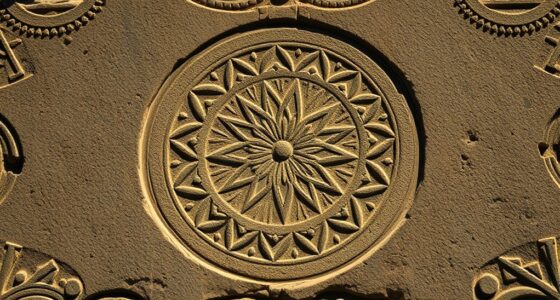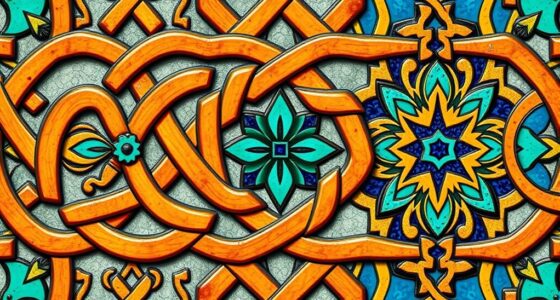The circle is sacred in many cultures because it symbolizes wholeness, unity, and the infinite nature of the universe. It represents life’s cycles, balance, and interconnectedness, reminding you that nothing exists in isolation. Across traditions, the circle embodies divine harmony and eternal life, inviting you to connect beyond physical boundaries. As you explore further, you’ll discover how this powerful shape continues to influence spiritual practices and cultural symbols worldwide.
Key Takeaways
- The circle symbolizes wholeness, unity, and infinity, representing the eternal cycle of life and interconnectedness in many cultures.
- It is used in sacred rituals and art to embody divine harmony, balance, and spiritual completeness.
- Native American and Eastern traditions utilize circles to emphasize spiritual renewal and life’s cyclical nature.
- In Christianity, circles appear in halos and aureoles, signifying divine presence and sacredness.
- As a vibrational symbol, the circle influences energy fields and encourages reflection on unity and life’s interconnectedness.

Have you ever wondered why circles hold such powerful symbolism across cultures and disciplines? It’s because the circle embodies a profound geometric significance that resonates deeply with human understanding of wholeness and unity. Unlike shapes with edges or angles, the circle has no beginning or end, making it a perfect representation of infinity and completeness. This seamless form invites you to see beyond physical boundaries and connect with something eternal, which explains why many spiritual traditions have embraced the circle as a sacred symbol. When you look at a circle, you’re witnessing a shape that is both simple and infinitely complex, embodying the endless cycle of life, death, and rebirth, or the interconnectedness of all things. Moreover, the vibrational energy associated with circular symbols can influence your own energy fields, aligning you more closely with your spiritual intentions. In spiritual terms, the circle often symbolizes wholeness and unity. You might find it in rituals, mandalas, and sacred art, where it acts as a visual reminder of the divine or the universe’s infinite nature. The spiritual representation of the circle isn’t just about the shape itself but what it signifies on a deeper level—oneness, balance, and harmony. As you meditate on circular symbols, you’re encouraged to reflect on the interconnectedness of your own life and the universe. The circle’s continuous form reminds you that everything is linked, that life’s cycles are constant, and that nothing exists in isolation. It’s a visual language that speaks to the soul’s desire for harmony and understanding of the greater whole.
Across different cultures, the circle’s sacredness persists in various forms. Native American tribes use it in ceremonies and sacred sites, emphasizing the cyclical nature of life and spiritual renewal. In Eastern philosophies, the circle appears in the form of the yin-yang symbol, representing the balance of opposing forces within the universe. In Christianity, the halo or aureole surrounding saints and divine figures takes the form of a circle, symbolizing divine perfection and eternity. These examples illustrate how the circle’s geometric significance transcends individual traditions, integrating into collective spiritual consciousness.
Frequently Asked Questions
Are Circles Used in Modern Religious Practices Globally?
Yes, circles are used in modern religious practices worldwide. You might participate in circle meditation, where the shape fosters unity and focus. Sacred geometry often influences spiritual art and architecture, emphasizing the circle’s divine significance. Whether in prayer circles, yoga sessions, or sacred rituals, the circle helps you connect with a higher purpose, creating an inclusive space that symbolizes eternity, wholeness, and spiritual harmony.
How Does the Circle Relate to Concepts of Infinity?
Imagine walking along a never-ending path, where every turn leads you back to where you started. That’s how a circle relates to infinity, symbolizing an eternal cycle with a limitless boundary. It reminds you that life, time, and energy flow endlessly without beginning or end. This continuous loop embodies infinity’s essence, showing that some concepts go beyond limits, forever connected in an unbroken, sacred dance.
What Are Some Common Circle Motifs in Ancient Artifacts?
You’ll notice common circle motifs in ancient artifacts as geometric patterns and decorative motifs, like spiral designs, concentric circles, and mandalas. These shapes often symbolize unity, eternity, and cosmic cycles. You might find them in pottery, jewelry, or carvings, where they serve both aesthetic and spiritual purposes. Their recurring presence highlights the cultural importance of the circle as a universal symbol of wholeness and connection across different civilizations.
Do Different Cultures Interpret the Circle’s Symbolism Similarly?
Different cultures often interpret the circle’s symbolism similarly, emphasizing cosmic unity and cyclical renewal. You’ll find that many see the circle as representing wholeness, eternity, and interconnectedness across traditions. Whether in spiritual rituals or art, this shared understanding highlights its universal significance. You recognize that these cultures value the circle’s endless form, symbolizing ongoing cycles of life, death, and rebirth, uniting people through its sacred and timeless meaning.
How Is the Circle Applied in Contemporary Spiritual Rituals?
Imagine a glowing ring of light surrounding you—this is how the circle manifests in contemporary spiritual rituals. You often use it in meditative practices or create a ritual circle formation to focus energy and intention. The circle’s continuous shape helps you feel connected, grounded, and protected, enhancing your spiritual experience. It’s a powerful tool that fosters unity and sacred space, making your rituals more meaningful and centered.
Conclusion
The circle’s sacred symbolism has endured for thousands of years, connecting countless cultures in a timeless embrace. You now hold the key to understanding why this simple shape wields such profound power—it’s the heartbeat of the universe itself. When you see a circle, you’re witnessing something so ancient and mighty that it could rival the stars in its significance. Embrace this knowledge, and let the circle remind you of life’s endless, sacred cycle.









